
Asterias is a genus of the Asteriidae family of sea stars. It includes several of the best-known species of sea stars, including the (Atlantic) common starfish, Asterias rubens, and the northern Pacific seastar, Asterias amurensis. The genus contains a total of eight species in all. All species have five arms and are native to shallow oceanic areas of cold to temperate parts of the Holarctic. These starfish have planktonic larvae. Asterias amurensis is an invasive species in Australia and can in some years become a pest in the Japanese mariculture industry.
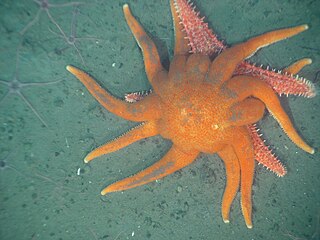
The Valvatida are an order of starfish in the class Asteroidea, which contains 695 species in 172 genera in 17 families.

The Echinasteridae are a family of starfish in the monotypic order Spinulosida. The family includes eight genera and about 133 species found on the seabed in various habitats around the world.

The Asterinidae are a large family of sea stars in the order Valvatida.
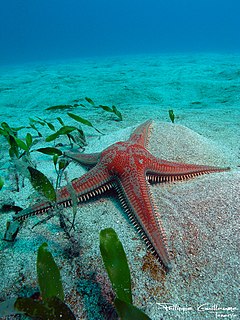
The Astropectinidae are a family of sea stars in the order Paxillosida. Usually, these starfish live on the seabed and immerse themselves in soft sediment such as sand and mud.

Astropecten is a genus of sea stars of the family Astropectinidae.

Limopsidae is a family of bivalves, related to the ark clams and bittersweets. This family contains about thirty species in seven genera.
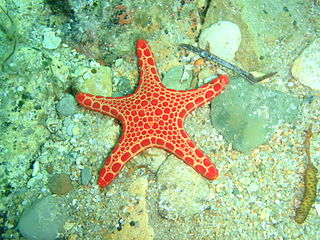
Goniasteridae constitute the largest family of sea stars, included in the order Valvatida. They are mostly deep-dwelling species, but the family also include several colorful shallow tropical species.

The Spinulosida are an order of sea stars containing at least 120 species in seven genera and two families.
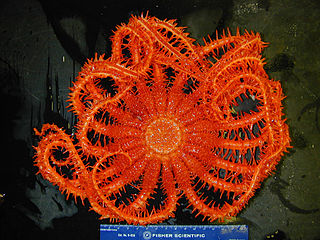
The Brisingids are deep-sea-dwelling starfish in the order Brisingida.

Newtoniellidae is a family of minute sea snails, marine gastropod mollusks or micromollusks in the superfamily Triphoroidea. It contains the following subfamilies :

Henricia is a large genus of slender-armed sea stars belonging to the family Echinasteridae. It contains about fifty species.

Odontasteridae is a family of sea stars. Members of the family are known as cushion stars and have relatively broad discs and five short tapering arms.

Leptasterias is a genus of starfish in the family Asteriidae. Members of this genus are characterised by having six arms although five-armed specimens sometimes occur. L. muelleri is the type species. The taxonomy of the genus is confusing and Leptasterias hexactis seems to be a species complex. Some species brood their eggs.

Solaster stimpsoni, common names Stimpson's sun star, sun star, orange sun star, striped sunstar, and sun sea star, is a species of starfish in the family Solasteridae.
The Brisingidae are a family of starfish found only in the deep sea. They inhabit both the Atlantic and Pacific Oceans at abyssal depths, and also occur in the Southern Ocean and around Antarctica at slightly shallower depths.
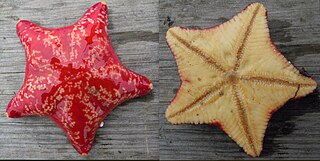
Poraniidae is a family of starfishes in the order Valvatida.
The Freyellidae are a family of deep-sea-dwelling starfish. It is one of two families in the order Brisingida. The majority of species in this family are found in Antarctic waters and near Australia. Other species have been found near New Zealand and the United States.

Asterodiscididae is a family of starfish. Members of the family have five short tapering arms and a wide disc. The family was first described by the Australian zoologist F.W.E. Rowe in 1977.
Asterias rathbuni is a starfish native to the Pacific coasts of Alaska in the United States and Far East Russia. There are two subspecies.















